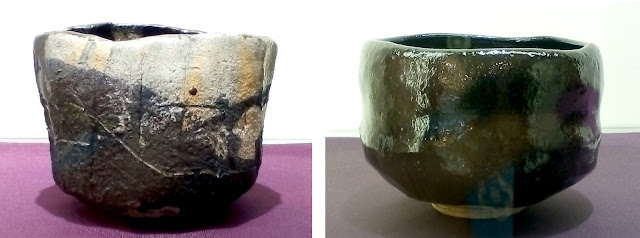I was always curious about bonsai pots the Japanese call Nanban. My
recent residency at Fujikawa Kouka-en in Osaka fuelled my curiosity about them
even further. After my return to Sydney, I wanted all the Nanban information I could
get. My first impulse was to search the Net, which brought only disappointment.
Then I remembered that John Naka had something about it in his “Bonsai
Techniques II”. Sure enough the book has a couple of short paragraphs about
Nanban containers, but it wasn't enough to quench
my thirst for knowledge.
Usually my access to Japanese sources is non-existent, but this time I
was lucky to find one. At Kouka-en nursery, I came across of the following book:
Nippon Bonsai Association (1990) Masterpieces of bonsai pot art - Grand
edition, Volumes I & II, Nippon Bonsai Association publication, Japan (美術盆器名品大成 , 日本盆栽協同組合編). These are
two absolutely magnificent volumes. Unfortunately, the book is out of print, prohibitively
expensive and in Japanese, which makes it somewhat inaccessible to the bonsai
community outside Japan. Volume II has a section titled “Nanban”. Below is my interpretative
translation of this section to English.
“The term Nanban referring to a particular kind of imported pottery is
vague and difficult to classify. Due to Japan’s national isolation during the
Tokugawa era, the precise meaning of the word Nanban, implying a foreign
country in the South, is obscure. Some believe that it is a name for Taiwan,
others think that it is a name of some other place in South-East Asia. In
short, the majority considers China, Korea, India and surrounds to be the most
likely places of Nanban’s origin.” This is a passage from an article by Zesora
Kobayashi published in 1935 September issue of “Bonsai” magazine. The author
was an eminent figure in the bonsai community, who brought Nanban pots into focus
in this excellent article, which later became a great point of reference.
Nanban doesn’t refer to a particular country or production area. It was
a collective term for certain artefacts used by tea masters in the world of art
and antiques. Before the Meiji era, miscellaneous utensils of daily use have
been brought over from the Southern seas for the tea masters of olden days. At
first, these containers have been used as vessels for flower arrangement. Being
highly prized, there was no way to satisfy the demand for them. Therefore at
the request of tea masters, potters such as Ninami Dohachi, Hozen Eiraku, Mokubei
Aoki and Miura Chikusen began making Nanban imitations. A wide range of
Japanese-made Nanban imitations included pottery from Bizen and Ryukyuan
Islands as well as Naeshirogawa ware of Satsuma and Shyodaiyaki ware of Higo.
All of them are collectively referred to as Nanban.
The earliest Nanban containers entered bonsai scene before the Meiji
period and were typically small round trough-shaped pots, dishes and jar lids,
which were modified into a bonsai pot by drilling holes in their bottom. These
were produced in Taiwan, Ryukyuan Islands, Luzon and according to Zesora
Kobayashi in Southern China.
There are only few tribes among Taiwan aboriginals which knew pottery.
One of them is the Yami tribe of the Orchid Island situated several dozen
nautical miles off the southern coast of Taiwan. It is also said that the Ami
tribe from the east coast plains of Taiwan, made yellowish colour ware referred
to as "hannera". Very primitive brown Nanban pots are assumed to be
from there. Apart from those, there were also seed storage jars brought from
Taiwan. It is believed that they have been made in Xiamen, China and then
brought to Japan via Taiwan.
During the thirty odd years between the 9th year of Keichō era (1613)
and the 12th year of Kan'ei era (1636), Tokugawa Ieyasu issued official
permits, allowing merchants to trade with Korea, Ming Empire, Luzon, Annam,
Cambodia and other places. Sea voyages exploring coastal areas extended from
Taiwan to Macau, Sumatra and Thailand. Some of the Nanban containers were brought
to Japan during this period.
The age of Nanban pots is generally not essential. They are primarily
admired and valued for their rustic grace and charm. At some point in the past,
a bonsai aesthete realised that these qualities would complement bonsai.
Unfortunately, the name of the person who introduced Nanban containers to
bonsai is unknown. Soon after that however, Nanban containers became quite
popular, while they were rather rare. Yonekichi Kibe of former Taikō-en bonsai
nursery has been the lead driver of the Nanban popularity till the late Meiji
period. In response to this popularity, Chinese merchants set up a production
of containers imitating Nanban shape and appearance. They were mostly produced
in Xiamen, Fujian from where they were shipped to Japan via Shanghai. This
supply of Nanban containers to Japan continued throughout the pre-war period
until 1941.
As explained above, it is not possible to ascertain the precise place of
origin of Nanban ware due to their wide geographic spread. The only exception
from Nanban category is the Yixing ware, despite of the fact that concave lids
for large storage jars were produced there. They are excluded from the Nanban
class because of the differences in texture and colour of the clay.
Nanban containers look primitive and amateurish, however making them
requires sound craftsmanship. Its simplicity and spontaneity makes them a
particularly natural choice for some bonsai, however one needs to overcome
certain mental resistance to fully embrace Nanban as such a choice.
This passage is all I know about Nanban pots so far. Below are the
illustrations which accompany the passage in the book. They should help you with a mental picture of
Nanban containers.








